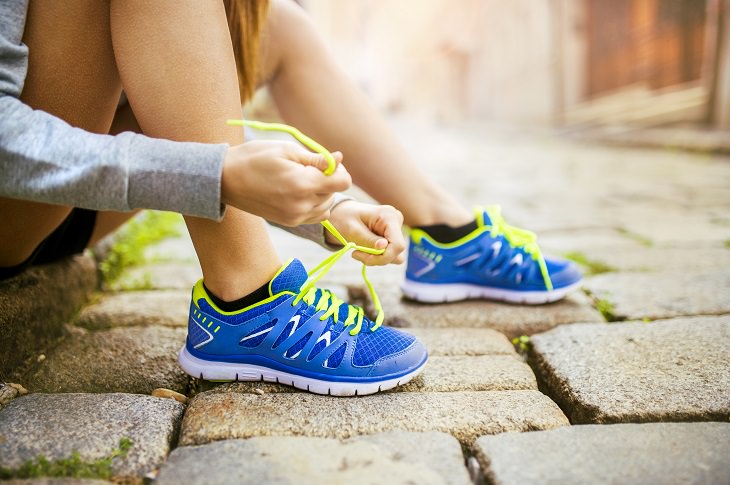
If you love a workout that you can do anywhere, or the thrill of competing in a 5K race, or just know that no other exercise is going to tone your abs and glutes as effectively as a jog, you’re not alone. Nearly 10% of Americans cite running as their preferred method of exercise, and considering the inherent full-body benefits, it’s little wonder those numbers continue to rise.
There’s a small problem though. Just because you think you know how to run doesn’t mean that you’re doing it correctly – or effectively. Whether you’re fueling up incorrectly beforehand, making mistakes with your gear, or simply messing up your form, there are a number of ways you can botch this exercise.
Below are 8 things that everyone does wrong while running.

By wearing the wrong shoes, you’re sabotaging yourself before you have even stepped out the door. Not only can choosing the wrong shoes make it much more difficult to run comfortably for a long period of time, it can also make you more injury-prone.
Glenn Dickstein, Founder and CEO of Neighborhood Trainers, says that “choosing the right footwear is crucial. It’s important to know your feet. Are you an overpronator or underpronator? High arch or low arch? Depending on your foot type, you’ll know if you need a show with more cushioning or more stability. Choosing the wrong shoes can result in pain, injury, and then, no running.”
It’s best if you go to a specialized athletic or running shoe store, where they do foot analysis. With their help, you can choose the best running shoes for you, depending on your foot shape, size, step, and bodyweight.
2. Tying Your Laces too Tight
While loosely-tied shoes can make your more susceptible to injury, over-tightening them can be just as bad. Shoes that are too tight can put pressure on the bones in your foot, forcing you to adopt an uneven gait, while potentially limiting your circulation, as well.

While you might be eager to immediately hit the pavement when you’re out for a jog, neglecting your warm-up can have some serious consequences. To help decrease your risk of future injury, make sure that you stretch before you start running, and ease into things at a gradual pace.
“If you don’t take a couple of minutes to stretch or warm up before a run, you’re increasing your chances of getting injured,” says Hoop.
4. Not Breathing Properly
Breathing comes naturally to all of us, but that doesn’t necessarily mean that you know how to breathe to best facilitate your run. This could result in you getting winded and giving up.
Dennis Hoop, an expert in senior and medical fitness, says that “breathing is the essence of all movement. Without proper breathing, you won’t get enough oxygen to your cells and you will fatigue very quickly. Find a breathing pattern that feels comfortable for you and that you can maintain consistency throughout your run, without any effort. When he runs, he uses two short inhales and one long exhale.

Although a lot of people associate mindfulness with more meditative activities, it’s also essential for an effective run. “When you’re being mindful, you will notice when your body is sending you signals, whether you’re feeling good and energized, or whether you’re getting out of breath and really struggling,” says Hoop.
If you’re not aware of how your body feels when you’re running, you can cause yourself to get injured by putting too much pressure on your joints.
6. Starting Your Run without Hydrating
A little water can go an awful long way when it comes to making you a better runner. However, it’s not just drinking during the run that helps – the key to a better run is making sure you’re adequately hydrated before you begin.
A number of studies have shown that a loss of 5% body water inhibits your performance by 30%. Therefore, make sure that you drink plenty of water around your workout time (before, during, and after). As a rule of thumb, you need to replace each ounce of lost body fluid with 2 ounces of fluids.

You keep track of plenty of metrics when it comes to your running habits, so why aren’t you monitoring your heart?
Your heart rate is a great monitor and tool to regulate the intensity of your run, as well as showing the progress of your fitness level. Imagine that you’re running at an 8-mile-per-hour pace, with a heart rate of 140, and six months later, you have a consistent 120 heart rate, at the same pace – that shows great progress. So buy yourself a good heart rate monitor and take advantage of the information you get out of it.
8. Eating the Wrong Foods
Eating the wrong foods can wreak havoc on our energy levels, and might even make us more prone to cramps while we’re exercising. Half an hour before you go for a run, eat a snack that includes protein and a complex carbohydrate such as whole wheat toast and peanut butter. You’ll see a difference in your energy levels from when you ran with an empty stomach.
Source: bestlifeonline
Images: depositphotos